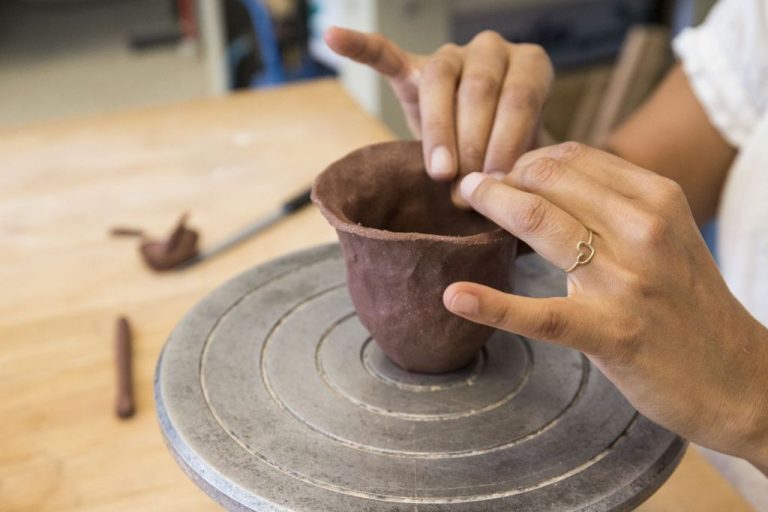Are Clay Utensils Good?
Clay utensils are dishes, cookware and tableware made from clay, an abundant natural material. Clay utensils have an ancient history, with evidence of their use for cooking, serving and eating food dating back over 10,000 years. Clay remains a popular material around the world for making utensils due to its versatility, natural origins and benefits.
Clay utensils stand out for their durability, heat resistance and eco-friendly nature. Unfired clay is naturally porous and becomes hardened when fired, creating sturdy dishes. Clay conducts heat well, allowing it to cook food evenly. As clay originates from soil, it’s more sustainable than utensils made from man-made materials. Clay is also thought to impart health benefits, as it’s a non-reactive material that doesn’t leach chemicals.
However, clay utensils do come with some downsides. They are breakable if dropped. Clay also requires extra care like hand-washing and proper drying to prevent damage. And specialty clay cookware can be more expensive than ubiquitous options like aluminum and stainless steel. But with the right usage and care, clay’s upsides often make it a valued, eco-conscious choice for home kitchens.
Pros of Clay Utensils
Clay utensils have several advantages that make them a popular choice for cooking and eating. Here are some of the main pros of using clay as a material for utensils:
Natural Material – Clay is an all-natural substance made from earth. It does not contain any synthetic chemicals, plastics or contaminants. This makes clay utensils safe and eco-friendly.
Non-Toxic – When fired at high temperatures, clay becomes inert and non-toxic. This prevents any chemicals from leaching into food prepared with clay cookware.
Heat Resistant – Clay is highly heat resistant and can withstand very high cooking temperatures. Clay pots and pans can be used on the stovetop and in the oven without risk of cracking.
Durable – Well-made clay utensils are very durable and can last for years with proper care. The firing process makes the clay strong and chip-resistant for long-term use.
Non-Stick – Unglazed clay has a naturally non-stick surface that allows food to gently release. This reduces the need for oils and butter during cooking.
Cons of Clay Utensils
While clay utensils have many benefits, they do come with some downsides to consider as well. Some of the main cons of using clay utensils include:
Heavy – Clay is denser and heavier than materials like plastic or metal. This can make clay dishes, pots, and utensils cumbersome to maneuver and lift, especially when full. The weight may be difficult for some people to manage.
Can break if dropped – Being brittle, clay utensils and dinnerware can crack, chip, or shatter if accidentally dropped on a hard surface. This risk requires more careful handling.
Hard to clean – Clay is porous and can absorb stains, flavors, and odors more easily than non-porous materials. This can make clay utensils harder to clean thoroughly after use.
Expensive – Well-crafted clay utensils are typically more expensive than comparable plastic or stainless steel options. The natural material and artisanal production process results in a higher price point.
Clay vs. Other Materials
Clay utensils have some distinct advantages and disadvantages compared to utensils made from metal, wood, plastic, or silicone.
Metal
Metal utensils like stainless steel are extremely durable and sturdy. However, metal can react with acidic foods, imparting a metallic taste. Clay is inert so it will not affect flavors. Metal can also scrape coatings off cookware. Clay is gentle on pans. On the downside, clay is more fragile than metal.
Wood
Wooden utensils are also relatively gentle on cookware coatings. They feel comfortable in the hand. But wood is porous and can harbor bacteria if not properly cleaned. Clay resists bacteria. Wood also cracks and splinters over time. High quality clay holds up better.
Plastic
Plastic utensils are inexpensive, lightweight, and come in a variety of colors. However, lower quality plastic can melt under high heat or contain BPA and other concerning chemicals. Natural clay does not contain these chemical additives. Plastic also wears out and scratches more quickly than clay.
Silicone
Silicone is a popular modern option. It’s flexible, heat-resistant, and non-stick. However, silicone is synthetically made rather than natural. Over time, silicone can deteriorate and collect odors. 100% clay maintains its integrity and does not retain smells.
Types of Clay for Utensils
There are several main types of clay that are commonly used to make utensils:
Terracotta
Terracotta clay is an unglazed, porous clay that is usually reddish-orange in color. It is one of the most ancient clays used for pottery and utensils. Terracotta cookware has good heat retention but the porous nature means it can absorb liquids and odors. Terracotta utensils have an earthy look and feel.
Earthenware
Earthenware is a general term for clay utensils fired at lower temperatures, making them porous and less durable than stoneware or porcelain. They may have a glazed or unglazed surface. Earthenware has good heat conduction but it is more delicate and prone to chipping.
Stoneware
Stoneware clay is fired at higher temperatures, making it less porous and more durable than earthenware. Stoneware utensils are opaque rather than translucent and hold up well to daily use. They withstand heat well while cooking. Stoneware comes in natural clay colors or vivid glazed hues.
Porcelain
Porcelain utensils are fired at extremely high temperatures, making them non-porous, durable, and resistant to staining. Porcelain has a smooth, glass-like surface and can be rather delicate. It withstands heating and sudden temperature changes. Porcelain utensils often have a clean, white appearance.
Maintenance
Clay utensils require some special care and maintenance to keep them in good condition. Here are some tips:
Handwash only – Clay utensils should always be handwashed, never put in the dishwasher. The harsh detergents and high heat can damage the clay.
Avoid metal utensils – Never use metal utensils with clay cookware and serveware. The metal can scratch and damage the clay. Use wood, silicone or other clay utensils.
Seasoning – New clay utensils may need some seasoning to achieve an optimal cooking surface. Lightly rub the interior with natural oils like coconut oil. Over time the clay will achieve its own natural patina.
Storing – Store clay utensils in a dry place. Allow cookware to fully dry before storing to prevent moisture damage. Hang utensils or place on open shelves.
Safety of Clay Utensils
When properly made, clay utensils are considered safe for cooking and eating. However, there are a few safety considerations to keep in mind:
Lead testing – Some clay can contain trace amounts of lead that can transfer to food during cooking. It’s important to use lead-free clay and glazes that have been independently lab tested and certified for food safety.
Firing temperature – Clay must reach high enough temperatures during the firing process to harden properly and make it non-porous. Underfired clay may allow bacteria to harbor in tiny pores. Reputable manufacturers follow specific protocols to ensure proper firing.
Non-toxic when fired properly – Fully vitrified clay that has been fired to the proper temperatures is inert and non-toxic. Any chemicals used in glazes or decorations must also be food-safe and free of heavy metals.
Avoid overheating – Just like metal pots and pans, clay can potentially leach trace minerals into food if overheated for a long time. Avoid subjecting clay to very high heat or flame for extended periods.
With high quality manufacturing and proper use, clay offers a safe, non-toxic option for cooking and serving food.
Top Brands
When it comes to the top brands for clay utensils, here are some of the most popular and highest quality options:
Kook Clay
Kook is an Indian brand known for its beautiful handcrafted clay pots, pans, cooker, and more. Their clay products are lead-free and made from high quality clay sourced locally in India.
Clay Craft
This brand based in the UK ethically handcrafts their clay cookware. Their elegantly designed pieces are crafted from natural clay sourced in Germany and make for great decorative statement pieces.
Maze Living
Maze Living focus on crafting modern and minimalist clay cookware perfect for contemporary kitchens. They are based in India and make sets of clay pans, pots, plates, and tumblers.
Chumbak
For those wanting fun, funky, and colorful clay cookware, Chumbak is a top choice. This Indian lifestyle brand makes playful and cheery utensils to brighten up your kitchen.
Ikea
The Swedish furniture giant also sells beautiful and affordable clay cookware like tagines, pans, dishes, and tableware made ethically in countries like Tunisia and Portugal.
Prices
The cost of clay utensils can vary quite a bit depending on the type and quality you choose. Here are some typical price ranges:
Terracotta: This is generally the most affordable option. Simple terracotta pots and pans can cost $5-$15. More ornate or decorative pieces may range from $15-$50.
Earthenware: Glazed earthenware tends to cost more than basic terracotta. Expect to pay $10-$30 for basic plates, bowls, cups and other pieces. Larger or more decorative earthenware items can cost $25-$75.
Stoneware: Being more durable than earthenware, stoneware prices are a bit higher. Basic stoneware mugs, bowls, and baking dishes usually range from $15-$40. More artisan stoneware can cost $40-$100.
Porcelain: As the most refined and delicate clay, porcelain commands the highest prices. Simple porcelain tea cups may start around $25 per piece, while complete dinnerware sets can easily cost over $200. Unique handmade porcelain pieces can cost $50-$300.
Conclusion
In summary, clay utensils have both pros and cons compared to other materials like metal or plastic. The main benefits of using clay utensils are that they are natural, non-reactive, and eco-friendly. Clay is inert, so it won’t leach chemicals or metals into food. Clay utensils are also more durable than plastic and don’t conduct heat like metal.
However, clay can be heavy, fragile if dropped, and requires more care like handwashing only. Clay utensils can also crack, stain, or absorb odors over time. They tend to be more expensive than plastic or silicone options.
For most household cooking, high quality clay pots, pans, and cookware make excellent additions to the kitchen. They can enhance flavors naturally and provide chemical-free cooking. However, clay plates, bowls, cups, and utensils may be less practical for daily use.
Plastic, wood, or stainless steel utensils are likely better options for flatware that receives rougher treatment. But for specialized uses like kneading dough, serving baked goods, or casual dining, clay utensils can be a stylish, natural choice.






